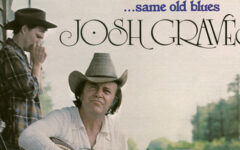
 At 70 years of age, most of us are thinking about slowing down and enjoying a well-deserved rest. But not John McEuen. The banjo maven has 50 years of professional music behind him and says that he is as excited about his new project, Made In Brooklyn, as anything else he has recorded. Coming from the brainchild behind the quintessential bluegrass collaboration, Will The Circle Be Unbroken with The Nitty Gritty Dirt Band and a bevy of bluegrass and country icons, that is quite a statement.
At 70 years of age, most of us are thinking about slowing down and enjoying a well-deserved rest. But not John McEuen. The banjo maven has 50 years of professional music behind him and says that he is as excited about his new project, Made In Brooklyn, as anything else he has recorded. Coming from the brainchild behind the quintessential bluegrass collaboration, Will The Circle Be Unbroken with The Nitty Gritty Dirt Band and a bevy of bluegrass and country icons, that is quite a statement.
When we spoke with John earlier this week, we kicked around the question of how to refer to this album of contemporary and traditional roots music. Americana surely describes this melange of eclectic styles with a home in the US. There’s bluegrass, blues, and folk music, but also elements of klezmer and dixieland in the mix. And some pop music sensibilities as well.
McEuen suggested that it was “advanced folk music,” or “mature American music.” Those are just right, though what occurred to me was “music for adults.”
Of course people of any age should enjoy this foray into several of the traditional musical genres this country has produced, but it might be most fully savored by listeners closer to John’s age, and those who have followed his long career in the business. It all makes perfect sense from that perspective.
He had an idea for a record, with a loose list of some songs he would include and some artists he would like to have with him in the studio, but it didn’t really gel until a chance conversation with Norman Chesky of Chesky Records about two and a half years ago. The label was launched by Norman and his brother David in 1978 to produce recordings that featured both high end audiophile quality paired with performers of the very highest abilities. They have since released critically acclaimed albums from jazz masters like McCoy Tyner, Ron Carter, Larry Coryell, and Bucky Pizzarelli using what they call a “dummy head” technique. A single microphone is placed in such a way as to capture a binaural signal that replicates how our two ears respond to sound, especially when you listen with headphones.
“When Norman described his process to me for recording acoustic music, we started planning this record. I had always been a fan of what Maybelle Carter did with AP and Sara when they sat in front of Ralph Peer’s microphone. If that’s all it takes to make great country music, what are we doing with all that other stuff?
All those classic recordings from Flatt & Scruggs and The Stanley Brothers were made that way, and fans of the Circle album will recall something Roy Acuff said before we started one of the songs… ‘Let’s get it right the first time and the hell with the rest of ’em.’ “
So McEuen started collecting songs for the record, and began contacting the various musicians he hoped would work with him. David Amram was invited to play flute, penny whistle, and percussion; David Bromberg on guitar and vocals; Matt Cartsonis for vocals, guitar, and mandola; Andy Goessling on guitar, mandolin, dobro, banjo, reeds, penny whistle and recorder; Steve Martin on banjo; Jay Ungar on fiddle; Skip Ward on bass; and John Carter Cash, Martha Redbone, and John Cowan to add their vocals. McEuen would supply guitar, mandolin, banjo, and fiddle, and serve as producer.
“This was a team of players that I had met over the years, ones I had wanted to play with. Most of them didn’t know each other, though they knew of each other. I had worked with them all on other projects
And these are songs I have wanted to record, in some cases for years, so they were selected first. It came about over a two year process of thinking about it.
All of these players were fifty years old or older with a wealth of experience in different sorts of music. We did a few rehearsals so that we were all familiar with the material before we convened in the studio.
It was the most effortless recording I’ve ever done. We recorded the album in two days, but I say it actually took two days and fifty years!”
Made In Brooklyn doesn’t release until September 30, but Chesky has dropped a debut single to stir up some advance interest. It’s Excitable Boy, one of two songs written by Warren Zevon on the record, and the title track of his 1978 album for Asylum Records. One might call it a decidedly creepy song, with a story that includes assault, murder, and grave desecration but John laughingly suggested, “We needed a new murder ballad out there.”
“Some people say I put the ‘tic’ in eclectic.
The guy singing it worked with Zevon the last few years of his life. Warren doesn’t have a lot of notice out there, especially in the folk music world. Matt and Dave sing it great, and the bluegrass treatment is nicely set off by the background vocals. It’s kind of like a wild ride through the the story.
And I really like my banjo solo. It’s so much fun when you’re playing live and you know that it’s not going to be fixed. The excitement of doing it all at once with everybody else is part of why I think it’s a good single.
That’s why I call it a record. It’s a record of the music we played at that time and moment.”
John said that he has devoted more time to publicity for this record than anything else he’s ever done. He didn’t say so specifically when we spoke, but I think this is a deeply personal project for him, getting together with other artists he respects and admires, and seeing what would happen when they assemble in the studio.
It’s a perfect match for Chesky’s recording technique, and when you hear the banjo kickoff in the sample above, the natural room reverb does sound a bit like a Lester and Earl cut from the ’50s.
“I hear it as an extension of the sensibilities of the Circle album… but we’re the old guys now. I’m 26 years older now than Earl Scruggs was when we recorded the Circle.”
Everything old is new again.







